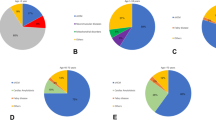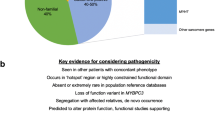Abstract
Purpose of Review
Hypertrophic cardiomyopathy (HCM) is a common inherited cardiac condition with potential for severe complications including sudden cardiac death. Early diagnosis allows appropriate risk stratification and prompt intervention to minimise the potential for adverse outcomes. The implications of poorly coordinated screening are significant, either missing relatives at high-risk or burdening low-risk individuals with a diagnosis associated with reduced life expectancy. We aim to guide clinicians through the diagnostic pathway through to novel treatment options. Several conditions mimic the condition, and we discuss the phenocopies and how to differentiate from HCM.
Recent Findings
We summarise the latest developments informing clinical decision making in the modern era of myosin inhibitors and future gene editing therapies. Early identification will enable prompt referral to specialist centres.
Summary
A diagnostic flowchart is included, to guide the general cardiology and heart failure clinician in important decision making regarding the care of the HCM patient and importantly their relatives at risk. We have highlighted the importance of screening because genotype-positive/phenotype-negative patients are likely to have the most to gain from novel therapies.





Similar content being viewed by others
References
Papers of particular interest, published recently, have been highlighted as: • Of importance •• Of major importance
•• Arbelo E, Protonotarios A, Gimeno JR, et al. 2023 ESC Guidelines for the management of cardiomyopathies: developed by the task force on the management of cardiomyopathies of the European Society of Cardiology (ESC). Eur Heart J 2023;44:3503–626. https://doi.org/10.1093/eurheartj/ehad194.The first guidelines for the management of all cardiomyopathies published by the European Society of Cardiology in 2023.
Pelliccia F, Gersh BJ, Camici PG. Gaps in evidence for risk stratification for sudden cardiac death in hypertrophic cardiomyopathy. Circulation. 2021;143:101–3. https://doi.org/10.1161/CIRCULATIONAHA.120.051968.
van Velzen HG, Vriesendorp PA, Oldenburg RA, et al. Value of genetic testing for the prediction of long-term outcome in patients with hypertrophic cardiomyopathy. Am J Cardiol. 2016. https://doi.org/10.1016/j.amjcard.2016.06.038.
Wolf CM. Hypertrophic cardiomyopathy: genetics and clinical perspectives. Cardiovasc Diagn Ther. 2019;9:S388-415. https://doi.org/10.21037/cdt.2019.02.01.
• Topriceanu C-C, Pereira AC, Moon JC, et al. Meta-analysis of penetrance and systematic review on transition to disease in genetic hypertrophic cardiomyopathy. Circulation 2023;149:107–23. https://doi.org/10.1161/circulationaha.123.065987. An important and recent study summarising the penetrance of HCM within families with sarcomeric variants, including data to discuss with patients during the genetic counselling process.
de Marvao A, McGurk KA, Zheng SL, et al. Phenotypic expression and outcomes in individuals with rare genetic variants of hypertrophic cardiomyopathy. J Am Coll Cardiol. 2021;78:1097–110. https://doi.org/10.1016/j.jacc.2021.07.017.
Towe EC, Bos JM, Ommen SR, et al. Genotype-phenotype correlations in apical variant hypertrophic cardiomyopathy. Congenit Heart Dis. 2015;10:E139–45. https://doi.org/10.1111/chd.12242.
Hancock EW, Deal BJ, Mirvis DM, et al. AHA/ACCF/HRS recommendations for the standardization and interpretation of the electrocardiogram: part V: electrocardiogram changes associated with cardiac chamber hypertrophy: a scientific statement from the American Heart Association Electrocardiography. J Am Coll Cardiol. 2009;53:992–1002. https://doi.org/10.1016/j.jacc.2008.12.015.
Corona-Villalobos CP, Sorensen LL, Pozios I, et al. Left ventricular wall thickness in patients with hypertrophic cardiomyopathy: a comparison between cardiac magnetic resonance imaging and echocardiography. Int J Cardiovasc Imaging. 2016;32:945–54. https://doi.org/10.1007/s10554-016-0858-4.
Ho CY, Cirino AL, Lakdawala NK, et al. Evolution of hypertrophic cardiomyopathy in sarcomere mutation carriers. Heart. 2016;102:1805–12. https://doi.org/10.1136/heartjnl-2016-310015.
Flett AS, Maestrini V, Milliken D, et al. Diagnosis of apical hypertrophic cardiomyopathy: T-wave inversion and relative but not absolute apical left ventricular hypertrophy. Int J Cardiol. 2015;183:143–8. https://doi.org/10.1016/j.ijcard.2015.01.054.
Licordari R, Trimarchi G, Teresi L, et al. Cardiac magnetic resonance in HCM phenocopies: from diagnosis to risk stratification and therapeutic management. J Clin Med. 2023;12:3481. https://doi.org/10.3390/jcm12103481.
• Maron BJ, Desai MY, Nishimura RA, et al. Management of hypertrophic cardiomyopathy: JACC state-of-the-art review. J Am Coll Cardiol 2022;79:390–414. https://doi.org/10.1016/j.jacc.2021.11.021. A recent review highlighting the significnace of scar burden as assessed by CMR in the risk stratification of HCM patients, when the imaging modality is available.
Nordin S, Kozor R, Bulluck H, et al. Cardiac fabry disease with late gadolinium enhancement is a chronic inflammatory cardiomyopathy. J Am Coll Cardiol. 2016;68:1707–8. https://doi.org/10.1016/j.jacc.2016.07.741.
Sado DM, White SK, Piechnik SK, et al. Identification and assessment of Anderson-Fabry disease by cardiovascular magnetic resonance noncontrast myocardial T1 mapping. Circ Cardiovasc Imaging. 2013;6:392–8. https://doi.org/10.1161/CIRCIMAGING.112.000070.
Pieroni M, Moon JC, Arbustini E, et al. Cardiac involvement in Fabry disease: JACC Review Topic of the Week. J Am Coll Cardiol. 2021;77:922–36. https://doi.org/10.1016/j.jacc.2020.12.024.
D’Ascenzi F, Anselmi F, Piu P, et al. Cardiac magnetic resonance normal reference values of biventricular size and function in male athlete’s heart. JACC Cardiovasc Imaging. 2019;12:1755–65. https://doi.org/10.1016/j.jcmg.2018.09.021.
Gati S, Sharma S, Pennell D. The role of cardiovascular magnetic resonance imaging in the assessment of highly trained athletes. JACC Cardiovasc Imaging. 2018;11:247–59. https://doi.org/10.1016/j.jcmg.2017.11.016.
Dungu JN, Anderson LJ, Whelan CJ, et al. Cardiac transthyretin amyloidosis. Heart. 2012;98:1546–54. https://doi.org/10.1136/heartjnl-2012-301924.
Martinez-Naharro A, Treibel TA, Abdel-Gadir A, et al. Magnetic resonance in transthyretin cardiac amyloidosis. J Am Coll Cardiol. 2017;70:466–77. https://doi.org/10.1016/j.jacc.2017.05.053.
Phelan D, Collier P, Thavendiranathan P, et al. Relative ‘apical sparing’ of longitudinal strain using two-dimensional speckle-tracking echocardiography is both sensitive and specific for the diagnosis of cardiac amyloidosis. Heart. 2012;98:1442–8. https://doi.org/10.1136/heartjnl-2012-302353.
Dungu JN, Valencia O, Pinney JH, et al. CMR-based differentiation of AL and ATTR cardiac amyloidosis. JACC Cardiovasc Imaging. 2014;7:133–42. https://doi.org/10.1016/j.jcmg.2013.08.015.
Gillmore JD, Maurer MS, Falk RH, et al. Non-biopsy diagnosis of cardiac transthyretin amyloidosis. Circulation. 2016;133:2404–12. https://doi.org/10.1161/CIRCULATIONAHA.116.021612.
Nativi-Nicolau J, Maurer MS. Amyloidosis cardiomyopathy: update in the diagnosis and treatment of the most common types. Curr Opin Cardiol 2018; 1. https://doi.org/10.1097/HCO.0000000000000547.
Brito D, Albrecht FC, de Arenaza DP, et al. World Heart Federation Consensus on transthyretin amyloidosis cardiomyopathy (ATTR-CM). Glob Heart. 2023;18:59. https://doi.org/10.5334/gh.1262.
Martinez HR, Beasley GS, Miller N, et al. Clinical insights into heritable cardiomyopathies. Front Genet. 2021;12. https://doi.org/10.3389/fgene.2021.663450.
Finocchiaro G, Dhutia H, Gray B, et al. Diagnostic yield of hypertrophic cardiomyopathy in first-degree relatives of decedents with idiopathic left ventricular hypertrophy. Europace. 2020;22:632–42. https://doi.org/10.1093/europace/euaa012.
Ho CY, Day SM, Axelsson A, et al. Valsartan in early-stage hypertrophic cardiomyopathy: a randomized phase 2 trial. Nat Med. 2021;27:1818–24. https://doi.org/10.1038/s41591-021-01505-4.
McDonagh TA, Metra M, Adamo M, et al. 2021 ESC Guidelines for the diagnosis and treatment of acute and chronic heart failure. Eur Heart J. 2021;42:3599–726. https://doi.org/10.1093/eurheartj/ehab368.
Heidenreich PA, Bozkurt B, Aguilar D, et al. 2022 AHA/ACC/HFSA Guideline for the management of heart failure. J Card Fail. 2022;28:e1-167. https://doi.org/10.1016/j.cardfail.2022.02.010.
Hindricks G, Potpara T, Dagres N, et al. 2020 ESC Guidelines for the diagnosis and management of atrial fibrillation developed in collaboration with the European Association for Cardio-Thoracic Surgery (EACTS). Eur Heart J. 2021;42:373–498. https://doi.org/10.1093/eurheartj/ehaa612.
Fumagalli C, Bonanni F, Beltrami M, et al. Incidence of stroke in patients with hypertrophic cardiomyopathy in stable sinus rhythm during long-term monitoring. Int J Cardiol. 2023;381:70–5. https://doi.org/10.1016/j.ijcard.2023.04.008.
• Ommen SR, Mital S, Burke MA, et al. 2020 AHA/ACC Guideline for the diagnosis and treatment of patients with hypertrophic cardiomyopathy: a report of the American College of Cardiology/American Heart Association Joint Committee on Clinical Practice Guidelines. J Am Coll Cardiol. 2020;76:e159–240. https://doi.org/10.1016/j.jacc.2020.08.045. American guidelines for the management of HCM. This article has combined the European and American approach to management as a pragmatic guide for the reader.
Dybro AM, Rasmussen TB, Nielsen RR, et al. Randomized trial of metoprolol in patients with obstructive hypertrophic cardiomyopathy. J Am Coll Cardiol. 2021;78:2505–17. https://doi.org/10.1016/j.jacc.2021.07.065.
•• Olivotto I, Oreziak A, Barriales-Villa R, et al. Mavacamten for treatment of symptomatic obstructive hypertrophic cardiomyopathy (EXPLORER-HCM): a randomised, double-blind, placebo-controlled, phase 3 trial. Lancet. 2020;396:759–69. https://doi.org/10.1016/S0140-6736(20)31792-X. A trial of myosin inhibition in HCM, marking a new era of management with a first-in-class agent investigated in HOCM patients.
Desai MY, Owens A, Wolski K, et al. Mavacamten in patients with hypertrophic cardiomyopathy referred for septal reduction: week 56 results from the VALOR-HCM randomized clinical trial. JAMA Cardiol. Published Online First: 28 August 2023. https://doi.org/10.1001/jamacardio.2023.3342.
Mavacamten for treating symptomatic obstructive hypertrophic cardiomyopathy. https://www.nice.org.uk/guidance/ta913/resources/mavacamten-for-treating-symptomatic-obstructive-hypertrophic-cardiomyopathy-pdf-82615485457861. 2023.
Maron MS, Masri A, Choudhury L, et al. Phase 2 study of aficamten in patients with obstructive hypertrophic cardiomyopathy. J Am Coll Cardiol. 2023;81:34–45. https://doi.org/10.1016/J.JACC.2022.10.020.
Coats CJ, Maron MS, Abraham TP, et al. Exercise capacity in patients with obstructive hypertrophic cardiomyopathy: SEQUOIA-HCM baseline characteristics and study design. JACC Hear Fail. 2024;12:199–215. https://doi.org/10.1016/j.jchf.2023.10.004.
Ananthakrishna R, Lee SL, Foote J, et al. Randomized controlled trial of perhexiline on regression of left ventricular hypertrophy in patients with symptomatic hypertrophic cardiomyopathy (RESOLVE-HCM trial). Am Heart J. 2021;240:101–13. https://doi.org/10.1016/J.AHJ.2021.06.010.
Farrant J, Dodd S, Vaughan C, et al. Rationale and design of a randomised trial of trientine in patients with hypertrophic cardiomyopathy. Heart. 2023;109:1175–82. https://doi.org/10.1136/HEARTJNL-2022-322271.
Zhang H, Yu C, Cheng Y, et al. Clinical trials in hypertrophic cardiomyopathy therapy: a comprehensive analysis of trials registered in global clinical databases. Drug Des Devel Ther. 2023;17:1863. https://doi.org/10.2147/DDDT.S413136.
Tafelmeier M, Baessler A, Wagner S, et al. Design of the SILICOFCM study: effect of sacubitril/valsartan vs lifestyle intervention on functional capacity in patients with hypertrophic cardiomyopathy. Clin Cardiol. 2020;43:430–40. https://doi.org/10.1002/CLC.23346.
• Luo F, Liu W, Bu H. MicroRNAs in hypertrophic cardiomyopathy: pathogenesis, diagnosis, treatment potential and roles as clinical biomarkers. Heart Fail Rev. 2022;27:2211–21. https://doi.org/10.1007/s10741-022-10231-z. A summary of novel microRNA therapeutic strategies in HCM, an exciting future treatment option.
• Strong A. CRISPR gene-editing therapies for hypertrophic cardiomyopathy. Nat Med. 2023;29:305–6. https://doi.org/10.1038/s41591-022-02184-5. Gene editing therapies are considered the future of all cardiomyopathy treatments, first trialled in ATTR amyloidosis and proven safe. More research is needed to assess potential side effects, but CRISPR-Cas9 gene editing is expected to be the mainstay of treatment in sarcomeric HCM patients within the next 10 years.
Author information
Authors and Affiliations
Contributions
All authors contributed to the manuscript text and revision.
Corresponding author
Ethics declarations
Conflict of Interest
JND received a fee from Bristol Myers Squibb to attend an advisory board meeting.
AHW, ADD, and HOS declare that they have no conflict of interest.
Human and Animal Rights and Informed Consent
This article does not contain any studies with human or animal subjects performed by any of the authors.
Additional information
Publisher's Note
Springer Nature remains neutral with regard to jurisdictional claims in published maps and institutional affiliations.
Rights and permissions
Springer Nature or its licensor (e.g. a society or other partner) holds exclusive rights to this article under a publishing agreement with the author(s) or other rightsholder(s); author self-archiving of the accepted manuscript version of this article is solely governed by the terms of such publishing agreement and applicable law.
About this article
Cite this article
Dungu, J.N., Hardy-Wallace, A., Dimarco, A.D. et al. Hypertrophic Cardiomyopathy. Curr Heart Fail Rep (2024). https://doi.org/10.1007/s11897-024-00654-0
Accepted:
Published:
DOI: https://doi.org/10.1007/s11897-024-00654-0




